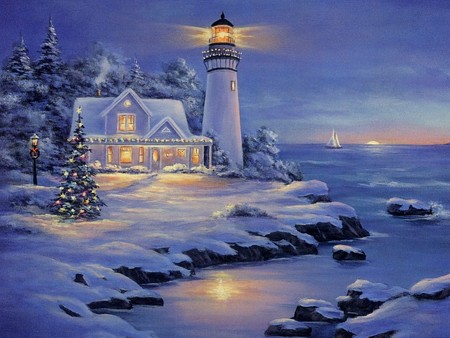Christmas at Sea
 When thinking of Christmas at sea one immediately turns to the traditional carol “I Saw Three Ships”. The song, repeatedly made popular by interpretations in modern recording ranging from Sting to Amy Grant to traditional orchestras, is a happy tune dating back to the 17th century.
When thinking of Christmas at sea one immediately turns to the traditional carol “I Saw Three Ships”. The song, repeatedly made popular by interpretations in modern recording ranging from Sting to Amy Grant to traditional orchestras, is a happy tune dating back to the 17th century.
But for all of its age and history, nobody really knows who wrote it or even what it entirely means.
The lyrics have confounded historians for centuries and it is believed the song’s connection to Christmas is merely a sailor’s song of hope.
After all, the song talks of three ships sailing into Bethlehem – a little town some 20 miles removed from the nearest body of water. Biblical stories abound of ships in the Dead Sea but it would be impossible for one ship even to sail into Bethlehem.
Some say the ships are symbolic of “ships of the desert”, otherwise known as camels. This rough connection at least makes a little sense as the three Magi have widely been regarded throughout history as arriving in Bethlehem on camels.
Three is a number of great significance to Christianity and the use of it in this song may reach beyond the Magi to the Trinity, giving the song a deeper meaning when it sings of three ships sailing into Bethlehem in Christmas day.
In all likelihood the song was likely a popular children’s tune that was modified to teach Christian principles, as many carols of Christmas are. The repetitive nature of the song, the happy melody and the clear Christian messaging made it ideal for teaching a holiday lesson to small children.
Christmas at Sea can largely be tied to the ancient character of St. Nicholas, who before morphing into a land locked character who took the skies was first instead the patron saint of sailors and of ships. This largely came about due to a miracle credited to Nicholas while he was Bishop of Myra.
As the legend goes, the land round about was suffering from a 3 year famine and in an effort to provide food for the starving citizens Nicholas approached the captains of the sea vessels anchored in the neighboring harbor. Knowing the hulls were full of grain bound for distant customers, Nicholas approached the captains asking for 10 percent of their cargo – a kind of Christmas tithing – with the promise that if each ship did so they would be accounted for full cargos when they reached their destination.
The miracle of the story focuses on feeding the people but for those who manned the ships the miracle made Nicholas famous around the world. In every port, the sailors told his story and they claimed him as their patron saint of safety on the high seas.
Many ports, most notably in Greece, have icons of Nicholas, surrounded by models of small ships made of silver or carved of wood. Sailors returning safely from sea, place these in gratitude to St. Nicholas for protection received. In some places sailors, instead of wishing one another luck, say, “May St. Nicholas hold the tiller.”
Nowhere are the influence of sailors and the message of Christmas showcased better than in the history of Christmas in the ancient and modern tropical paradise of Hawaii.
The very first Christmas Day celebrated in Hawaii was in 1786 by the English sea captain George Dixon and his crew aboard the Queen Charlotte. The ship was anchored in Waimea Bay off the island of Kauai. The celebration consisted of a special feast prepared for the crew and captain by the cooks in the galley.
In 1819, Christmas trinkets were given to island children by the English sea captain, Nathaniel Portlock, followed by food gifts presented by ambassadors. Until 1837, Christmas was not celebrated regularly by the residents of the islands. This coincided with the slow reversal of the Puritan ban on Christmas celebration activities in New England.
In 1856, the ruler of the Hawaiian Islands, King Kamehameha IV, proclaimed December 25 to be the official day of thanksgiving.
In 1858, Santa Claus (Kanakaloka) made his first appearance to the Hawaiian Islands by delivering presents to Hawaiian children. Santa’s Hawaiian name is Kanakaloka. Try writing that on your next letter to the big guy.
In 1862, Christmas Day was officially proclaimed a national holiday by King Kamehameha IV who was mourning the loss of his son, the heir to the throne.
The northern seaport city of Halifax, Nova Scotia on the eastern Canadian sea board was recently in the news for the commemorative events surrounding the 100th anniversary of the sinking of the Titanic.
Halifax was the city of rescue for the Titanic and more than 100 victims from the Titanic are buried there, forever making Halifax a tourist destination for Titanic enthusiasts.
There was a time – a Christmastime, in fact – when Halifax was a city rescued. In happened just five short years after the fateful sailing of the Titanic:
On a crisp December morning in the harbor at Halifax an empty freighter and a French munitions ship – both part of the war effort in Europe where World War I was raging – passed each other in the narrowest part of the harbor. Somehow the two ships collided, sparking a fire about the munitions ship.
Because they were in the narrow part of the harbor both ships were clearly visible on two shorelines and in the busy port hundreds of spectators pressed their faces against the glass windows of shops, businesses and homes. While the fire was a spectacle they had no way of knowing that the ship on fire contained a full cargo hold of explosives.
Within minutes the highly explosive cargo of TNT, picric acid and benzol fuel ignited – sucking more than a cubic mile of air out of the atmosphere and launching a fireball seen miles away. Nothing within 2 miles of the explosion was unaffected. Modern estimates place the force of the blast equivalent to 3 kilotons of TNT, a far cry from the 15 kilotons estimated for the atomic bomb dropped on Japan years later but still significantly large enough to label it the largest man-made explosion in history up to that time.
The explosion was so large it immediately emptied the harbor completely of all its water, briefly exposing the sea floor for the first time ever. The blast shattered every window within 50 miles and instantly killed 1000 people in the immediate vicinity. As the sky rained down burning pieces of the two ships the water of a mini-tsunami flooded the shoreline for miles around, creating a mess almost impossible to navigate once rescue crews arrived.
To make matters worse, Halifax was under a storm watch and within hours after the blast rescuers had to contend with 16 inches of snow hampering rescue efforts.
It was in this moment of crisis that word spread around the world and the nearest large popular center – Boston, Massachusetts – responded. By 10pm the day of the explosing a large relief train filled with medical supplies, food, emergency essentials and rescue personnel was on the way, a train that literally had to dig its way through the snow to reach Halifax.
Boston sent train after train in the days leading up to Christmas. In fact, as the cleanup continued they sent Christmas itself to a city population suddenly destitute of means for winter survival. By Christmas 1918 a year later, the trains stopped coming because Halifax was back on its feet – thanks to the continual efforts of the good people and many churches in Boston. In a token of thanks, the city of Halifax in 1918 sent a beautiful, giant Halifax fir to serve as the city of Boston’s Christmas tree – a tradition that continues to this day as both Boston and Halifax remember.
Christmas at sea is rich in history. Nearly every season of war also has tales of Christmas at sea, too.








